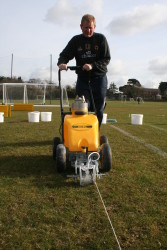October Rugby Diary
 With the season well underway most groundstaff will now have a better understanding of how their pitch is performing.
With the season well underway most groundstaff will now have a better understanding of how their pitch is performing.
Presentation and good management of your pitches are essential for attracting and retaining players. There is really no excuse for poorly maintained pitches, there are plenty of resources and information now available to clubs, both from the RFU and dedicated sites like Pitchcare.
Many parts of the country are experiencing prolonged dry spells with many pitches now drying out and becoming quite hard. It may be beneficial to raise your height of cut to help the grass cope with the stress of being dry, while at the same time the extra herbage cover will help prevent player injury.
If you have the means to water, then do so. Watering the pitches is imperative to keep the sward growing and help any applied nutrients to take affect.
Grass heights will vary depending on type of mowers used, however, most will be looking to maintain a height of cut between 25-75mm. Particular attention should be made when mowing and marking out, presentation of the pitch is important. A quality, well presented pitch inspires players to play well.
 Check with the sports governing body (RFU) for any amendments to the laws and markings of the pitch. Care should be taken when initially marking out new lines, ensuring that they are true, straight and measured correctly, using the 3,4,5 method to achieve accurate angles. A selection of line marking paints and markers are availble in the Pitchcare shop
Check with the sports governing body (RFU) for any amendments to the laws and markings of the pitch. Care should be taken when initially marking out new lines, ensuring that they are true, straight and measured correctly, using the 3,4,5 method to achieve accurate angles. A selection of line marking paints and markers are availble in the Pitchcare shop
If the grass is maintained at a height above 50 mm it may better to mow the lines with a pedestrian rotary mower. This helps define the lines and prepare the surface for marking.
There are a number of machines available for marking out lines, wheel to wheel, spray jet, dry liners and aerosol markers. The choice will be dependent on cost, efficiency and the type of line you want. Use string lines to help keep lines straight. Keeping your marking equipment in good order and clean will help you produce better quality lines; dirty and unkept markers tend to malfunction, drip and leak.
Regular brushing/sweeping will help keep the sward in good condition, particularly when done in the early mornings to remove the dew from the surface, thus reducing the ideal climatic conditions for disease to take hold.
Nutrients can be washed out of the soil profiles particularly sandy soils. Maintaining a healthy sward is essential, so it is important to monitor the nutrient status of your soils.
Fertiliser treatment and turf tonics can be continued in accordance with your annual programme. If you haven't got a fertiliser programme, have your soil tested; try an independent soil analysis company for an impartial set of results. Generally, autumn fertilisers will have now been applied but, because of the continuing mild weather, there is still time. The next opportunity to fertilise will come next spring when the soil and air temperatures rise.
Ideally, you should be considering a NPK fertliser product that is low in N something like a Scotts Sportsmaster Autumn 4:12:12.
 Hand or machine aeration aids surface drainage, at varying depths of penetration to prevent the development of a soil pan. As last month, if there is opportunity to aerate, then do it. Regular autumn aeration provides air space for the roots to expand into and allows the plant to breathe. Achieving an improved root system will stand you in good stead for the coming winter months.
Hand or machine aeration aids surface drainage, at varying depths of penetration to prevent the development of a soil pan. As last month, if there is opportunity to aerate, then do it. Regular autumn aeration provides air space for the roots to expand into and allows the plant to breathe. Achieving an improved root system will stand you in good stead for the coming winter months.
Harrowing/raking, especially after games, will help restore levels and keep surfaces open.
Some facilities have irrigation equipment, pop up systems/self travelling sprinklers. Always keep an eye out for leaks and broken parts; unwanted leaks can lead to costly problems, and surface playability can be compromised. Water is a valuable resource and should be treated as such.
Worn, sparse or bare areas can still be seeded in October. Use germination sheets to aid this process, but remove them regularly to check for diseases. Remember that without good seed to soil contact the operation is useless. Ensure you use new seed as old material may not give you the required germination rates.
Inspect and clean machinery after use; service and repair damaged machinery.
